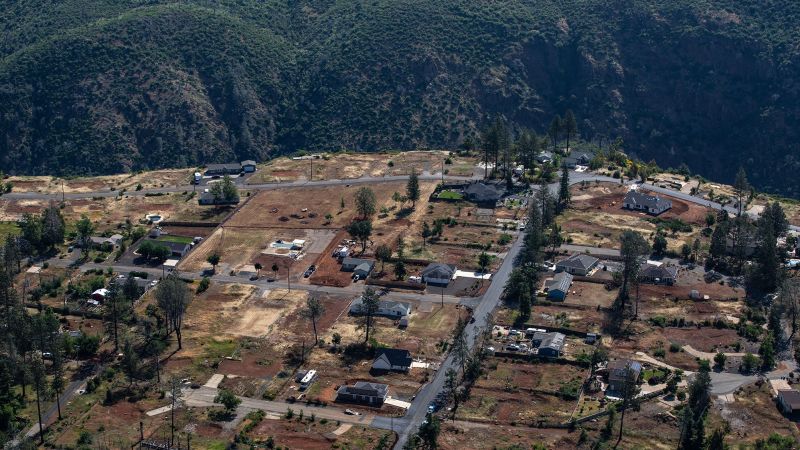New York
CNN
—
Homeowners insurance is becoming more expensive and, in many places, more difficult to find. There’s no sign that the situation is going to get better any time soon.
The culprits: climate change, rising costs to rebuild or make repairs and a sharp increase in the premiums from reinsurance companies that are used by insurers to limit their risks.
Major insurance companies have already virtually pulled out of the Florida market, leaving homeowners paying premiums nearly four times higher than those paid elsewhere in the country. Hurricane risk is part of Florida’s problem – Hurricane Ian last year was the most expensive storm ever to hit the state.
But Florida not the only state where natural disasters are causing insurers to pull back from the market.
Two of the largest national insurers, State Farm and Allstate, are no longer writing new homeowners policies in California, partly because of the increased risk posed to homes by wildfires.
Climate change isn’t the only factor. Insurance companies also point to the rising cost of replacing homes, as inflation for building supplies and labor has soared. The companies also blame limits placed on insurance premiums in some states, including California.
“The cost to insure new home customers in California is far higher than the price they would pay for policies due to wildfires, higher costs for repairing homes, and higher reinsurance premiums,” said a statement from Allstate explaining its decision to stop writing new policies last fall.
The insurance industry says that rebuilding and replacement costs surged 55% between 2019 and 2022. And reinsurance, the type of insurance that used by insurers to limit their risks, has gone up between 30% and 40% after years of losses in the industry, according to Matthew Carletti, an insurance industry analyst for JMP Securities.
“If you are a reinsurer, you have lost money for the last five years,” said Carletti. “They’ve had enough.”
The increased frequency of natural disasters is a major factor driving insurers to pull out of some markets and for reinsurers to raise their rates, which affects the premiums everyone pays, according to the experts.
“For the reinsurers, it’s not just inflation but increases in frequency of events,” Carletti said.
Insurance premiums nationwide aren’t up significantly – only 1.6% in the last 12 months according to the Consumer Price Index, the government’s main inflation measure. But double-digit rate increases are common in areas where insurance is becoming tougher to find.
Allstate and State Farm pulling back from writing new policies in California “shouldn’t be a surprise,” given the string of climate change-fueled wildfires in the state, said California’s former insurance commissioner Dave Jones.
“Insurers are responding rationally to the growing losses and growing risks by declining to write new insurance,” Jones said. “The risk is too great for the insurer to make any money. That has been occurring for some time now.”
Uninsurable places are growing across all 50 states, experts said, but that’s especially true in California, Florida and Louisiana, which have larger and more frequent disasters like hurricanes and wildfires.
There are different factors at play in all three states, but similar outcomes are happening: More people are being driven to the state-supported insurer of last resort, where they typically have to pay more money for a narrower policy. While Allstate and State Farm have declined to write new policies, smaller insurers in states like Louisiana and Florida have gone bankrupt – driving people out of their insurance altogether.
For instance, in Louisiana, 17% of homeowners insurance policyholders had their policies canceled last year, according to an annual report from Louisiana State University. Meanwhile, more than two-thirds of policyholders said homeowners and flood insurance are more expensive in Louisiana than other states.
More and more states are looking to start state-backed insurance providers to be the “insurer of last resort” for homeowners who are not able to find policies elsewhere. But in Florida, Citizens Property Insurance, the state insurance provider for the last 20 years, has seen the number of policies rise about 50% in the last year alone to 1.3 million, equal to 16% of the market and far more than any national insurer writes in the state.
Carletti says major insurers pulling out of big markets, as they have already done in Florida, could soon be spreading to other states, especially those that place limits on the percentage increase in premiums they can charge.
“A lot of states can learn a lesson from Florida,” he said. “Insurers don’t have to write policies in all 50 states. They are going to write policies where they think they can get a return on the capital.”
Wildfires in California are down in 2023 compared to the same period of last year, with 1,200 wildfires reported so far this year – roughly half the total from the first five months of 2022.
And wildfires have declined in each of the last two years from the record wildfire year of 2020, when more than 11,000 structures in the state were destroyed by 8,648 wildfires. In 2022 there were a total of about 7,500 wildfires, but only about 772 structures were destroyed.
But wildfires could surge later this year. Recent heavy rains fed the growth of grasses and other plants that could dry out later this year and provide fuel for the fires to come.
More broadly, rising temperatures could increase the risk of extreme wildfires worldwide in the coming years. The number of extreme wildfire events will increase up to 14% by 2030, according to the analysis by the UN Environment Programme. By 2050, the increase will climb to 30%, according to the forecast.
By the end of Frank Frievalt’s four-decade-long tenure as a fire chief in California and Nevada, the megafires leveling the region year after year were starting to blend together.
“You used to remember your career fires,” Frievalt said. “Initially, you’d see it as a one-off year. Then we had (the Paradise, California, fire in 2018) and thought that was as bad as it could get. And we just kept stacking them one on another.”
Sumber: www.cnn.com






